In 1919, the Australian government announced a prize of £10,000 for the first Australians in a British aircraft to fly from Great Britain to Australia within 30 days. This challenge attracted six teams of adventurous airmen, who set out to make history with their daring flights across continents and oceans. However, only one team managed to complete the journey and claim the prize: the brothers Ross and Keith Smith, and their mechanics Wally Shier and Jim Bennett, in a modified Vickers Vimy bomber.

Vickers Vimy crew flying into Sydney - PRG-18-7-59 - https://www.catalog.slsa.sa.gov.au:443/record=b3197928~S1
Vickers Vimy and crew, Ross Smith, Keith Smith, James Bennett, and Walter Shiers, flying into Sydney 14/2/1920
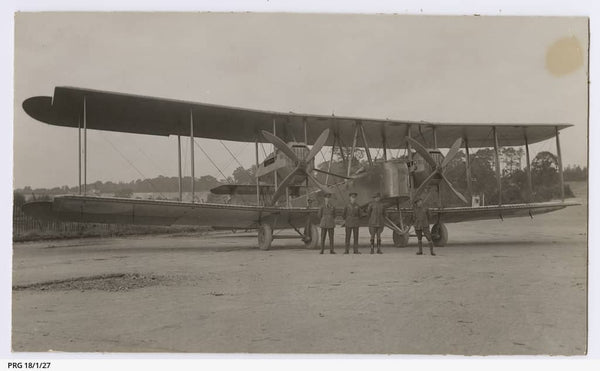
Lieutenant Keith Smith, Captain Ross Smith, and Sergeants Bennett and Shiers in England - PRG-18-1-27 - https://www.catalog.slsa.sa.gov.au:443/record=b3197202~S1
Left to right: pilots Lieutenant Keith Smith and Captain Ross Smith, with mechanics Sergeant James Bennett, and Sergeant Wally Shiers, standing by the Vickers Vimy G-EAOU at Hounslow Heath, England, at the start of the England to Australia flight.
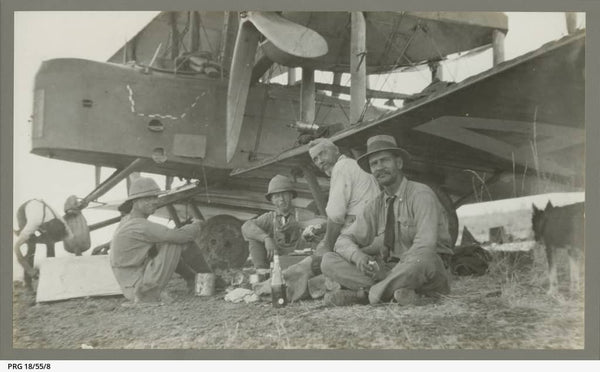
Vickers Vimy and crew at Cobbs Creek - PRG-18-55-8 - https://www.catalog.slsa.sa.gov.au:443/record=b3199348~S1
Vickers Vimy crew with W. Peacock and Sergeant Shetton of the Police, enjoying lunch at Cobbs Creek, Northern Territory, 14 December 1919.
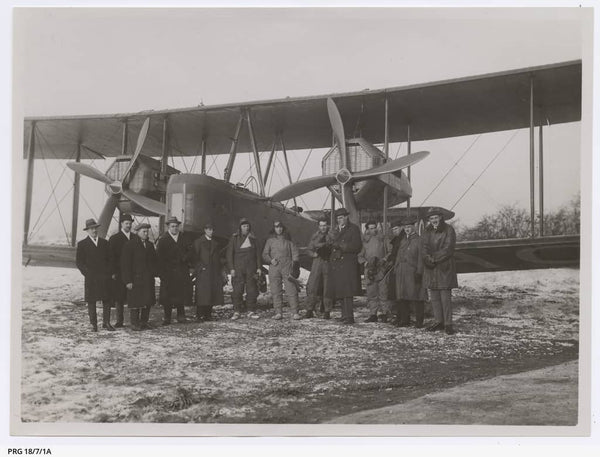
Group with the Vickers Vimy, Hounslow - PRG-18-7-1A https://www.catalog.slsa.sa.gov.au:443/record=b3197679~S1
Group photograph taken in front of the Vickers Vimy on a snowy day at Hounslow, London 12/11/1919. In flying clothes, from left to right: Sir Ross Smith, Sir Keith Smith, Sergeant Bennett and Sergeant Shiers. The tall man between Bennett and Shiers in R.K. Pierson, the designer of the Vickers Vimy.
In early 1919, the Commonwealth Government of Australia offered a prize of £A10,000 for the first flight from Great Britain to Australia, under specific conditions. In May 1919, Billy Hughes, Prime Minister of Australia, and Senator George Pearce, Minister for Defence (Australia), in consultation with the Royal Aero Club, stated that valid aircrews must all be Australian nationals, the aircraft must have been constructed in the British Empire, and the journey must be completed within 720 consecutive hours (30 days) and be completed before midnight on 31 December 1920. The departure point must be either Hounslow Heath Aerodrome (for landplanes) or RNAS Calshot (for seaplanes and flying boats), with reporting points at Alexandria and Singapore, and final destination in the region of Darwin. Each flight was to take place under the competition rules of the Royal Aero Club, that would supervise the start, and control the competition generally.

Goldeneye - Unisex Heavy Cotton Tee
## The Vickers Vimy: A War Machine Turned Peaceful ##
The Vickers Vimy was a twin-engine heavy bomber that was designed during World War I, but saw limited action before the war ended. It had a wingspan of 20.7 meters, a length of 13.3 meters, and a height of 4.5 meters. It could carry a crew of four and a bomb load of up to 907 kilograms. It was powered by two Rolls-Royce Eagle VIII engines, each producing 360 horsepower. It had a maximum speed of 166 kilometers per hour, a range of 1,120 kilometers, and a service ceiling of 2,140 meters.
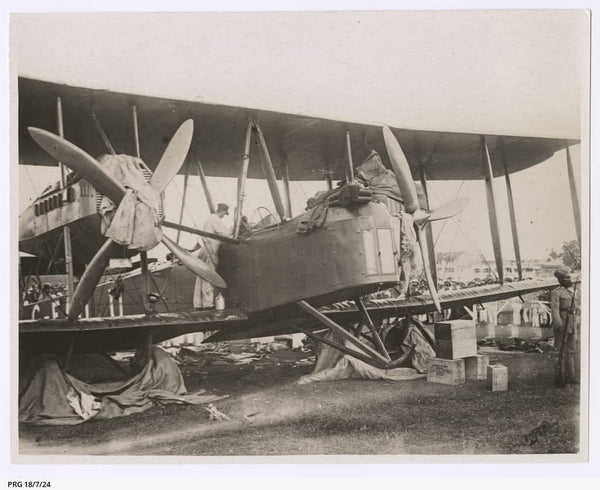
Vickers Vimy undergoing an overhaul at Singapore - PRG-18-7-24 - https://www.catalog.slsa.sa.gov.au:443/record=b3197858~S1
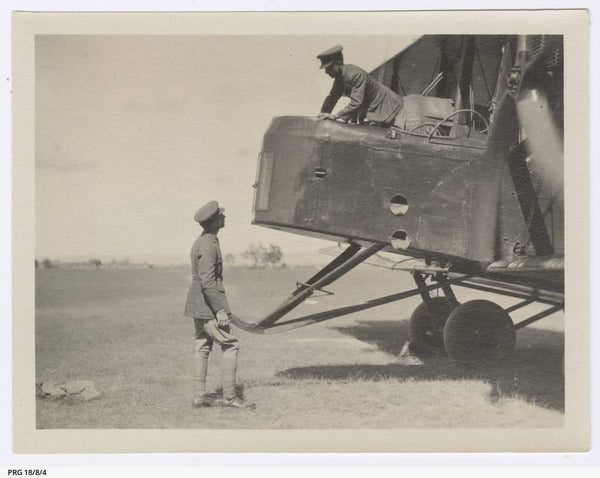
Ross and Keith Smith with the Vickers Vimy - PRG-18-8-4 - https://www.catalog.slsa.sa.gov.au:443/record=b3198014~S1
Ross and Keith Smith at the nose of the Vickers Vimy, after landing in Sydney, New South Wales. Photograph by Walter Burke, Challis House, Sydney.
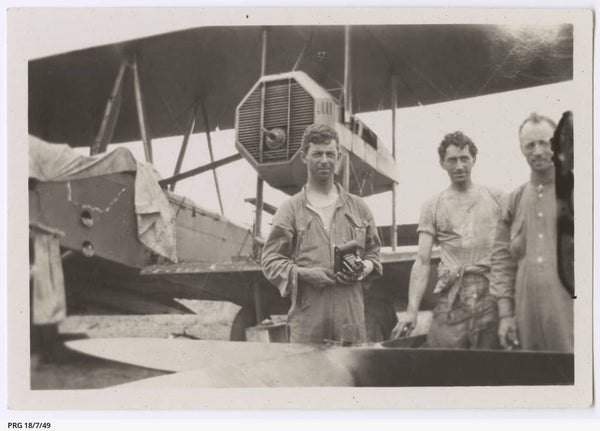
https://www.catalog.slsa.sa.gov.au:443/record=b3197895~S1
Ross and Keith Smith with James Bennett, standing by the Vickers Vimy at Cobbs Creek, Northern Territory, 14-17/12/1919.

## The Journey: A Test of Endurance and Skill
The Smith brothers and their mechanics took off from Hounslow Heath Aerodrome near London on November 12, 1919, at 8:18 am. They flew over France, Italy, Greece, Egypt, Iraq, Iran, Pakistan, India, Myanmar, Thailand, Malaysia, Indonesia, and Timor, before reaching Darwin in Australia on December 10, 1919, at 4:10 pm. They covered a distance of about 18,000 kilometers in 28 days, with a total flying time of 135 hours.
The flight was not without difficulties and dangers. They faced bad weather, engine failures, navigation errors, mechanical breakdowns, hostile locals, and wild animals. They had to land at various places along the way to refuel, repair, and rest. Some of these places were remote and unfamiliar, with no proper facilities or communication. They also had to deal with bureaucratic delays and political tensions in some countries.
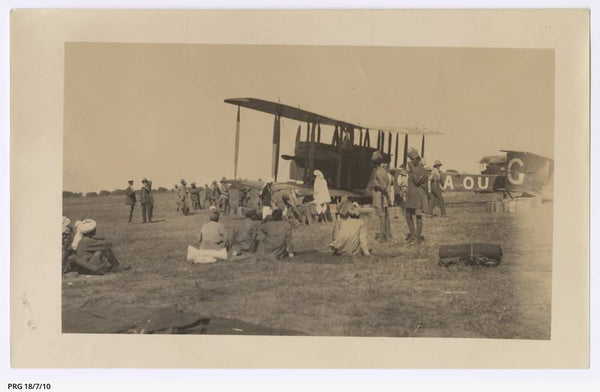
https://www.catalog.slsa.sa.gov.au:443/record=b3197836~S1
1919 November 26 - Vickers Vimy surrounded by onlookers at Delhi, India 25-27/11/19
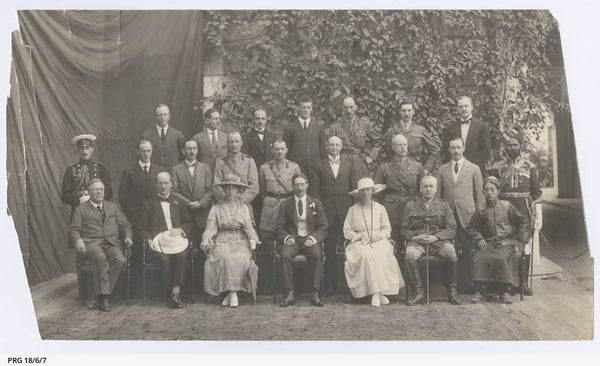
Group portrait of Ross Smith and officials at Government House, Calcutta - PRG-18-6-7 - https://www.catalog.slsa.sa.gov.au:443/record=b3197675~S1 Group portrait taken at Government House, Calcutta at the house party, January 1919.
Left to right: (sitting) Sir Frank Sly, Lord Southborough, Lady Munro, The Governor (Lord Ronaldshay), Miss Graham, The Commander in Chief (Sir Charles Munro), and the Maharaja of Sikkim; (middle) Captain Lyons (A.D.C.), Mr Clauson, Major Sands, Major Muir, Major Macartney, Mr Hailey, Major-General Scott, Mr Campbell, and Risalda Faiz Muhuad Khan (A.D.C.); (back row) Ross Smith, Captain Hyde (A.D.C.), Captain Haskett-Smith (A.D.C.), Mr Wilkinson, Captain Bridges, Captain Troutbeck, and Captain Vaux.
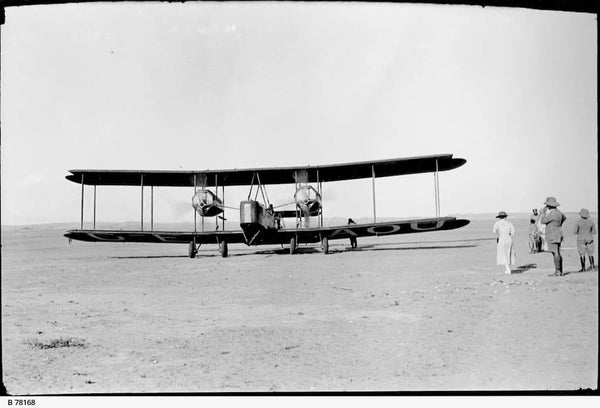
The Vickers Vimy and crew about to take-off from Bandar Abbas, Iran on 24 November 1919. One of ten photographs of the 1919 England-Australia Air Race taken by George Alexander MunGavin, the British Consul at Bandar Abbas, on the southern coast of Iran on the, Persian Gulf, and in charge of the Indo-European Telegraph Department's telegraph station there.
Goldeneye - Unisex Heavy Cotton Tee
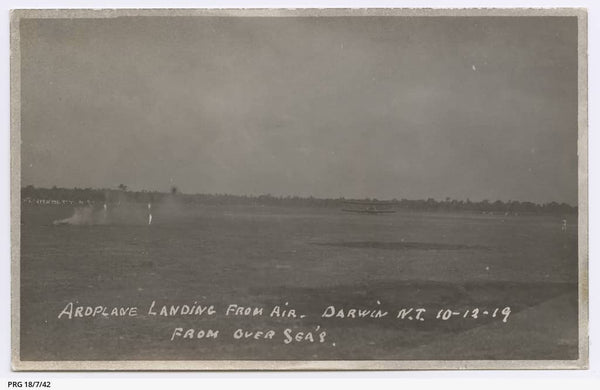
https://www.catalog.slsa.sa.gov.au:443/record=b3197887~S1
Vickers Vimy landing at Port Darwin 10/12/1919.
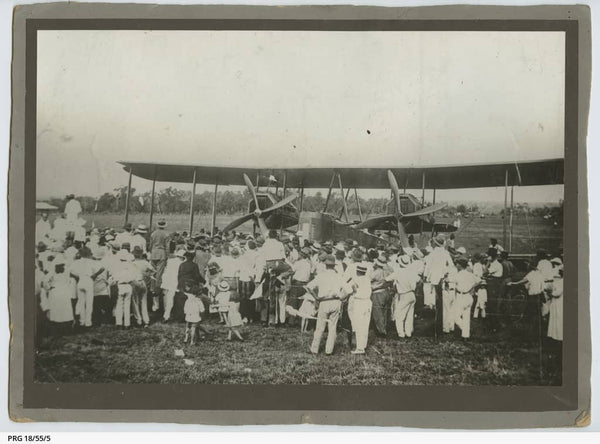
https://www.catalog.slsa.sa.gov.au:443/record=b3199345~S1
Spectators gathered at Fannie Bay airfield in Darwin to view the arrival of the Vickers Vimy and crew, 10 December 1919.
When they arrived in Darwin, they were greeted by a large crowd of cheering people who had been waiting for them for hours. They were also met by officials from the Australian government and the Royal Aero Club, who verified their flight and awarded them the prize money. They were immediately hailed as national heroes and aviation pioneers.
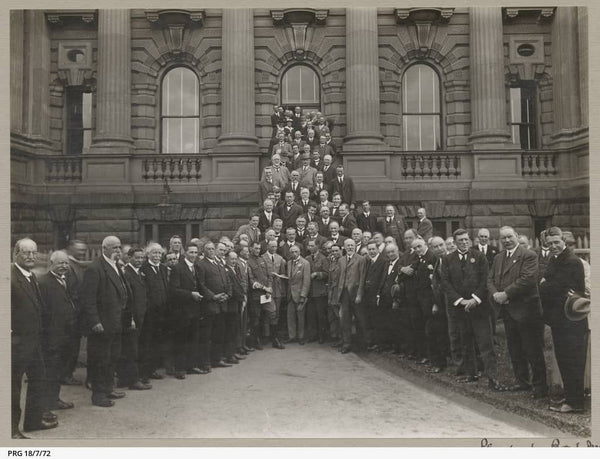
https://www.catalog.slsa.sa.gov.au:443/record=b3197955~S1
Group photograph featuring the Vickers Vimy crew meeting Prime Minister W.M. Hughes and other officials. In the centre of the photograph, left to right: James Bennett, Ross Smith, Prime Minister William Morris Hughes, Keith Smith, Andrew Smith, Walter Shiers.
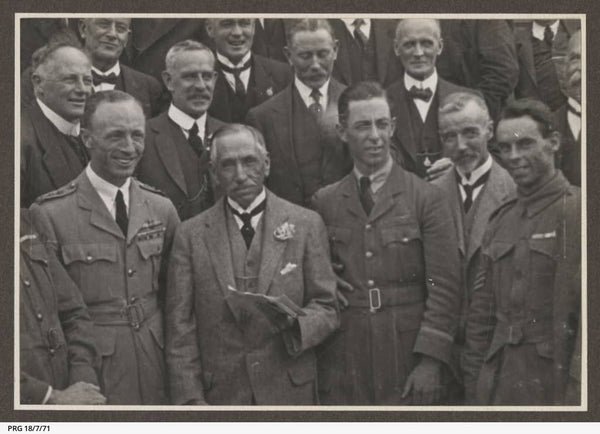
https://www.catalog.slsa.sa.gov.au:443/record=b3197952~S1
Group photograph featuring the Vickers Vimy crew meeting Prime Minister W.M. Hughes. Left to right: Ross Smith, Prime Minister William Morris Hughes, Keith Smith, Andrew Smith, Walter Shiers.
They then flew to Adelaide, Melbourne, Sydney, Brisbane, and back to Adelaide again, where they received more enthusiastic receptions and celebrations. They were also honored by various institutions and organizations with medals, trophies, certificates, and gifts.
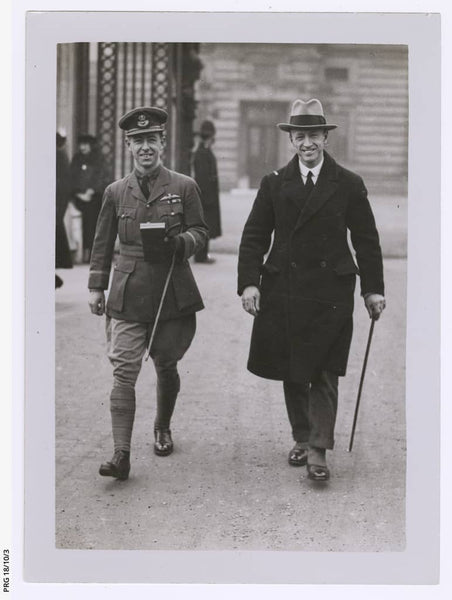
https://www.catalog.slsa.sa.gov.au:443/record=b3198812~S1
Ross and Keith Smith leaving Buckingham Palace after Keith was knighted as a member of the Order of the British Empire (K.B.E.) by King George V, in recognition of the England-Australia flight.
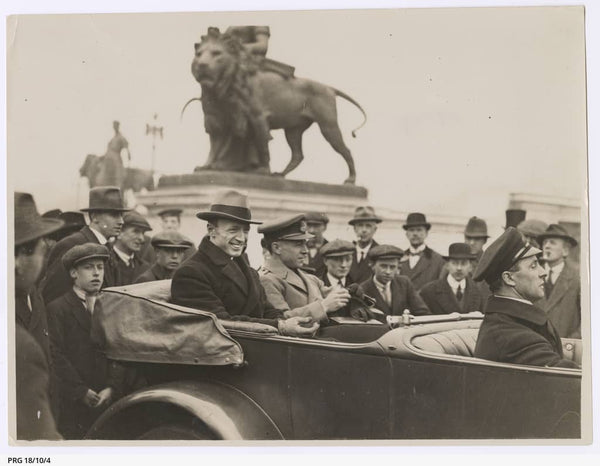
https://www.catalog.slsa.sa.gov.au:443/record=b3198818~S1
Ross and Keith Smith in a car outside Buckingham Palace, after Keith received his knighthood as a member of the Order of the British Empire (K.B.E.) from King George V, in recognition of the England-Australia flight. A crowd of well-wishers is gathered around the car.

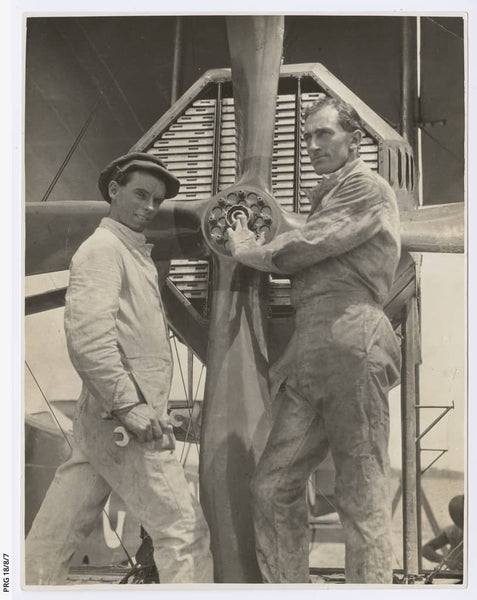
https://www.catalog.slsa.sa.gov.au:443/record=b3198017~S1
Mechanics Walter Shiers and James Bennett assessing the engine and propeller of the Vickers Vimy.
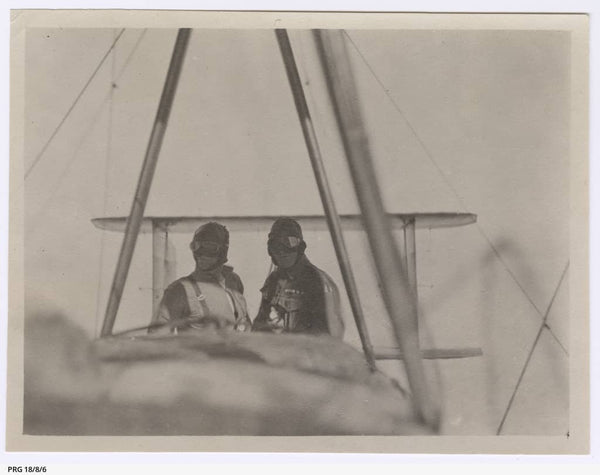
https://www.catalog.slsa.sa.gov.au:443/record=b3198016~S1
View of James Bennett and Walter Shiers in the rear of the Vickers Vimy during flight.
The Vickers Vimy was donated to the Australian government and is now preserved at the Adelaide Airport as a monument to the historic flight.
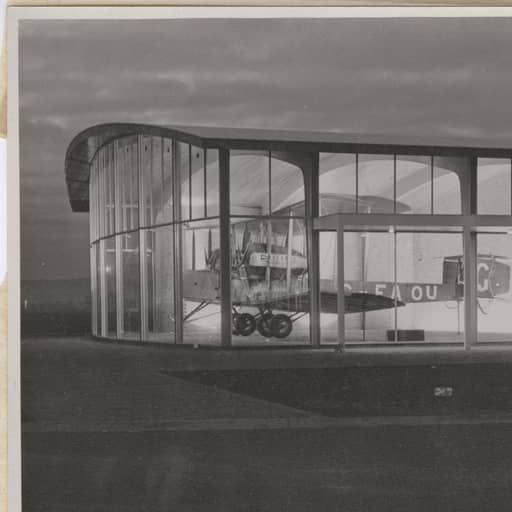
Vickers Vimy at Adelaide Airport
https://www.catalog.slsa.sa.gov.au:443/record=b3199330~S1

## The Legacy: A Milestone in Aviation History
The first flight from England to Australia was more than just a race for a prize. It was a demonstration of human courage, ingenuity, and perseverance in overcoming the challenges of air travel in its early days. It was also a catalyst for the development of civil aviation in Australia and the world. It showed the potential and feasibility of long-distance flights for commercial and military purposes. It also inspired and influenced many other aviators who followed in their footsteps and made their own contributions to aviation history.
The first flight from England to Australia was a historic event that took place in 1919. It was a remarkable feat of aviation that deserves to be remembered and celebrated.
## References##
: https://en.wikipedia.org/wiki/Vickers_Vimy
: https://www.awm.gov.au/articles/blog/the-1919-air-race
: https://www.sl.nsw.gov.au/stories/aviation-australia/vickers-vimy
: https://www.westtorrens.sa.gov.au/Council/Local-history/West-Torrens-Local-Highlights/1919-England-to-Australia-Air-Race
: https://www.smithsonianmag.com/air-space-magazine/england-to-australia-in-1919-124880927/

Vickers Vimy and crew departing Bandar Abbas – https://www.catalog.slsa.sa.gov.au:443/record=b3235270~S1
The Vickers Vimy and crew about to take-off from Bandar Abbas, Iran on 24 November 1919. One of ten photographs of the 1919 England-Australia Air Race taken by George Alexander MunGavin, the British Consul at Bandar Abbas, on the southern coast of Iran on the, Persian Gulf, and in charge of the Indo-European Telegraph Department's telegraph station there.

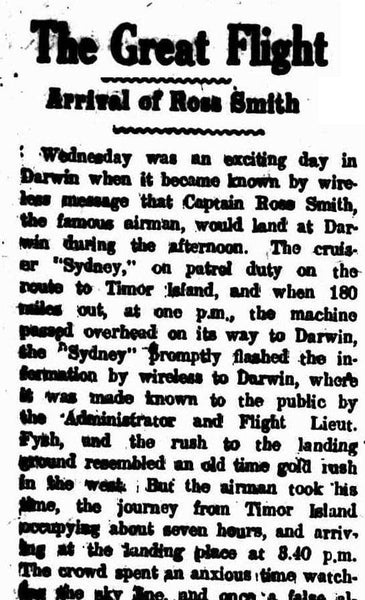
1919 'The Great Flight', Northern Territory Times and Gazette (Darwin, NT : 1873 - 1927), 13 December, p. 5. , viewed 29 Nov 2023, http://nla.gov.au/nla.news-article3299549
Article Transcript
The Great Flight
Arrival of Ross Smith
Wednesday was an exciting day in Darwin when it became known by wireless message that Captain Ross Smith, the famous airman, would land at Darwin during the afternoon. The cruiser "Sydney," on patrol duty on the route to Timor Island, and when 180 miles out, at one p.m., the machine passed overhead on its way to Darwin, the "Sydney" promptly flashed the information by wireless to Darwin, where it was made known to the public by the Administrator and Flight Lieut. Fysh, and the rush to the landing ground resembled an old-time gold rush in the west. But the airman took his time, the journey from Timor Island occupying about seven hours, and arriving at the landing place at 3.40 p.m. The crowd spent an anxious time watching the sky line, and once a false alarm was created by the appearance of an enormous pelican or some similar bird, which in the distance, looked very like a plane. The roar of the engine was heard before the machine was sighted. Ross Smith seemed to be making for the landing place as if he knew exactly where it was, circled over it to detect a suitable landing and volplaned down smoothly and easily and landed on the ground with the grace and ease of some giant bird.
The quarantine officers had wirelessed that the airmen would have to be medically examined before being allowed to go among the people.The aviators were formally welcomed by Mayor Toupein, who read the following address:
To Captain Ross Smith, D.F.C., and Lieut. Keith Smith, and Party.
The citizens of the Northern Territory of Australia are privileged to be the first to welcome you valiant knights of the air who have crossed the wide continents and oceans of the world; whose dauntless courage has conquered the last of the elements and made it the handmaid of progress and civilisation. We are especially gratified to feel that the victory has been won by Australians who have been trained in many an aerial conflict in the late war. This great contest over space in which you have been so signally successful, has placed the copingstone on the triumphal arch reared by Australian valour on the great battlefields of the world. It has enshrined Australian chivalry and resource in the pantheon of the nations where the whole world will do homage to your unique exploit.
Signed on behalf of the residents of the Northern Territory
- TOUPEIN.
Mayor. STANIFORTH SMITH,
Acting Administrator. Darwin, N.T., Australia.
December 11, 1919.
The Administrator (Mr. Staniforth Smith) was also asked by the Mayor to give a short address of welcome.
Mr. Smith said the arrival of the aeroplane was an epoch in the history of the world. For thousands of years fine conquest of the air had been the dream of the world. From the time of the ancient Greeks who made an ascent of some kind but got too near the sun which melted tile wax in their wings and they fell into the Aegian Sea. After all these years of struggle he was proud to know that the great conquest had been made by Australians, and today the world would quiver with pride at the victory of our fellow Australians. (Cheers.) Captain Ross Smith and his men had performed deeds of valor and courage which all true Australians valued most, and had exhibited unequalled nerve and endurance.
(The Administrator was frequently interrupted with good humoured remarks and bursts of applause).
Captain Ross Smith briefly responded. He was indeed glad to get back again into Australia, and especially to Darwin, where he had received such a splendid welcome. He had set-out from London hoping to make the trip in 30 days, but he was proud to be able to say he had done it in 28 days. He was thankful for the honor he personally had received, but after all the most arduous and important work was done by his two mechanics (Sergeants Bennett and Shires.)
MESSAGES OF CONGRATULATION.
Many hundreds of cable messages and wireless messages and telegrams of congratulation on accomplishing their great flight awaited Captain Ross Smith on his arrival at Darwin. These included a message from the Prime Minister (Mr. Hughes) and messages from all parts of Australia.
The Administrator received the following message from H.M.A.S. Sydney: "We request that you will give the following message to Captain Ross Smith from the Captain, officers and ship's company of H.M.A.S. Sydney — Many thanks for your kind message received in latitude ten degrees, 57 minutes south, longitude 128 east. We offer our heartiest congratulations to you and your companions on winning the greatest race in the history of the world, and on the skill, gallantry, and endurance which you have all shown. We are particularly proud to feel that the first pilot to fly from England to Australia is an Australian."
The Administrator also received this message from Western Australia—"Will you kindly deliver for us a message which we particularly wish given to the first aviator arriving in Darwin as follows: The North-western Members in the Parliament of Western Australia, Australia welcome your safe arrival on the soil of Northern Australia. Your wonderful performance thrills us with admiration. We congratulate you as the first great air pilot of Australia fulfilling the prophesy of Tennyson when he dipped into the future and saw the vision of the wonders that would be. By your achievement the world is brought closer to us realising visions for humanity of joy and delight." This is signed by Sir Edward Wittenoom, P. Durack, R. W. Underwood, F. W. Teasdale and E. H. Angelo.
The following address has been presented on behalf of the employees of the North Australian Meat Company and contains about 200 signatures in all:—Captain Ross Smith and Party. Dear Sir,—We herewith wish to express our appreciation of your splendid achievement. Some of us do not know anything about flying, but we saw the final direct flight to the landing paddock and the final landing of your machine in Darwin, Australia, and are pleased to state that both efforts were carried on in an expert and absolutely perfect manner. The undertaking is one that requires all the best qualities of mankind, and we take our hats off to the party who manipulated the air-ship. Any honors that are bestowed upon the party will not be too great, and in conclusion we wish you all the best of health and a successful finish to the balance of your flight. Good luck and best wishes.
Goldeneye - Unisex Heavy Cotton Tee
INCIDENTS OF THE VOYAGE.
Flying high and strong the Vickers Vimy aeroplane manned by Ross Smith and his companions crossed the coast of Australia at twenty minutes past three o'clock on Wednesday afternoon. Less than half an hour later it had landed on Australian soil at the Fannie Bay aerodrome and the flight from London to Australia, the longest in the history of the world, was over. The aviators have still to cross a continent, but that is a minor matter after crossing parts of three continents and of two oceans. The actual flying time from London to Darwin was one hundred and twenty-four hours and the average speed about eighty five miles an hour.
Darwin, which justified its title of the front door of Australia on this occasion, was on the tiptoe of expectation all day. The first actual news that the aviators had begun the last stage of their journey was given by a wireless message from Koepang, in Timor, stating that the aviators had spent the night in Timor and were then leaving for Darwin. The first to sight the aeroplane was an employee at Vestey's, who modestly refused to give his name. The pilot took for his land mark the lighthouse at Point Charles sixteen miles from Darwin, and those on-board sighted Darwin itself when forty miles away and flying at six thousand feet. The gigantic aeroplane came straight for the aerodrome, gradually coming down to about two thous-and feet. The white guiding-mark in the centre was picked out nearly twenty miles away. The landing was perfect.
Before Captain Ross Smith, neat clean-shaved and with his uniform as spick-and-span, was allowed to leave the machine and shake hands with Lieutenant Fysh, who welcomed him to Australia on behalf of the Defence Department, he had to be examined by the quarantine officer (Dr. Harris). He and his three companions, his brother Lieutenant Ross Smith, and the two mechanics, Sergeants Bennett and Shiers, passed with honors. "If I could have reached you, I would have asked you what you would like to eat and drink when you first touched Australia if it had cost my last shilling," said Captain Dempsey on arrival of the aviators at his residence. Captain Ross Smith replied that there could be nothing better than the home-made cakes and liquid refreshment provided, except the warmth of the welcome given to them by their fellow Australians. The quarantine examination was not the only official barrier that the aviators had to pass. Mr. Geraghty, Customs Officer at Darwin, sought to see that all was in order. Captain Ross Smith replied that the machine had been examined by the Customs officers in London and passed and that there had been no request for examination made by the Customs at any of their stopping places. It is a clean washout, he said. "We have nothing on board but spare parts, a little oil and petrol, pyjamas, a few clothes and a tin of bully beef stowed away somewhere," added Lieu-tenant Keith Smith. "I will give you my assurance that there is nothing dutiable on board," said Captain Ross Smith. Eventually the aviators were given a list of dutiable articles and it was decided that next day they should look through it and see everything was in order. 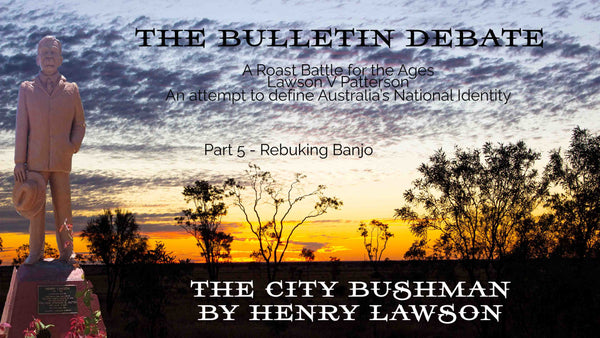
THE VOYAGE TO AUSTRALIA.
The machine, which is a 360 horse-power Vickery-Vimy of the type used in the flight across the Atlantic, left London on November 12. It flew by way of Italy, Egypt, India and Burma to Bangkok in Siam, then to Singapore and from Singapore the route ran through Java, touching at Soerabaya to Anatopo in Timor. The last stopping place is five hundred miles from Darwin. The aeroplane left shortly after half-past eight on Wednesday morning, covering the flight in about seven hours. A good deal of bad weather was encountered on the way. Early in the flight the machine had to land at Pisa, in Italy, on a ground covered by about 18 inches of water. Storms were met later but usually avoided by rising above them. At Akyab, in Bur-ma, the Vickers-Vimy overtook Poulet, who was flying what one of the aviators described as "a rotten old bus." They left about the same time as Poulet next morning, but beat him by an hour. Poulet took this like a good sport, and next day both machines got under way for Bangkok. A storm encountered seemed to be too much for Poulet and they saw him no more.

https://www.catalog.slsa.sa.gov.au:443/record=b3197201~S1 Ross and Keith Smith taking notes at the wing of their Vickers Vimy aircraft.
The Vickers-Vimy had its worst time at Soerabaya, in Java. It landed on some reclaimed ground and was nearly bogged, going right down on one side till one wing was nearly in the mud. Next morning it threatened to stick fast, but about 300 coolies got to work and covered an area 300 yards long with bamboo matting. This enabled the machine to get a run and rise.
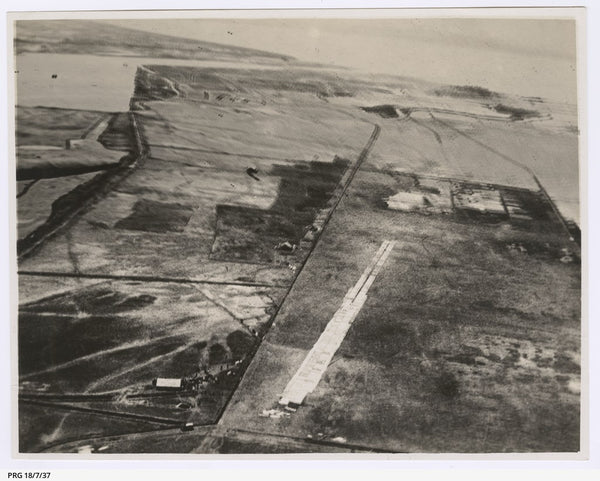
https://www.catalog.slsa.sa.gov.au:443/record=b3197882~S1
Aerial photograph of bamboo matting runway at Surabaya, Indonesia, 8/12/1919.
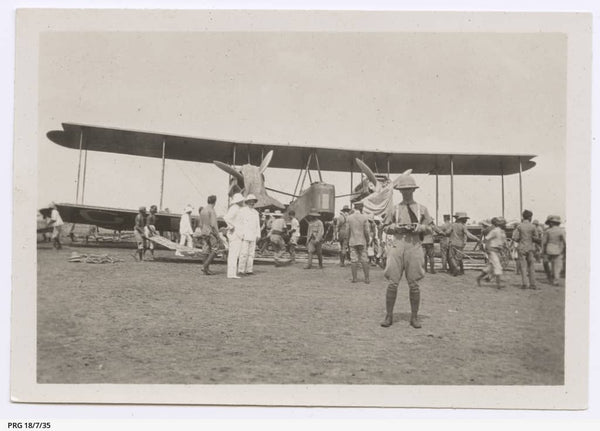
https://www.catalog.slsa.sa.gov.au:443/record=b3197879~S1
Digging out the Vickers Vimy utilizing bamboo matting track at Surabaya, Indonesia, 7/12/1919.

https://www.catalog.slsa.sa.gov.au:443/record=b3197880~S1
Natives towing the Vickers Vimy along bamboo matting track at Surabaya, Indonesia, 7/12/1919.
The aeroplane was flying very light during the last part of the voyage. At Singapore the aviators jettisoned a photographic outfit and everything else that could be spared. "Not on your life," said Lieutenant Ross Smith, when asked if he had a wireless outfit. "It would weigh a hundred and fifty pounds and would not be worth it. Unless we had the means of giving an absolutely accurate position, what would be the use of sending out a S.O.S. call and wasting people's time looking for us. One of the aviators expressed the opinion that the disaster which overtook Captain Ross and Douglas (who were killed in England) was due to having the machine overloaded. The aviators paid a tribute to the remarkable kindness and hospitality shown them by the Dutch residents at the places at which they stopped in the Netherlands. No one treated us like the Hollanders, said one of the mechanics. "They will do me. Nothing that they could do for us was left undone. They fed us well and looked after us in every way." With the exception of a few reserves, such as the tin of bully beef, the aviators, carried no food with them. They depended on securing it at the stopping places. Their last meal before reaching Australia was a few sandwiches given to them before they left Timor. The weather in the Netherlands Indies was very bad, very hot and close, except when they were actually flying and well above the earth, and with occasional heavy storms. One of the mechanics summed up his views of the journey as a whole by saying that he would not do it again for a hundred thousand pounds. "Believe me," he said, "it was no joyride. The engines went well, but of course I've had to work practically every night at one thing or another. However, it's all right now."
One of the last things the aviators heard in London made them feel a little uncertain about what they would find at Darwin. The newsboys were calling out "Revolution in Australia," and selling by thousands newspapers giving a highly colored account of the trouble in the Territory.
AVIATOR'S FUTURE MOVEMENTS. Captain Ross Smith will stay two days in Darwin so that his engines may be overhauled. On Saturday (today) he will leave for the south. The first stage will probably be to Cloncurry, where Lieutenant M'Guinness is in charge of a supply depot. If necessary, however, he can land at Newcastle Waters on the way. From Cloncurry the aviators will follow the route mapped out by the Defence Department. 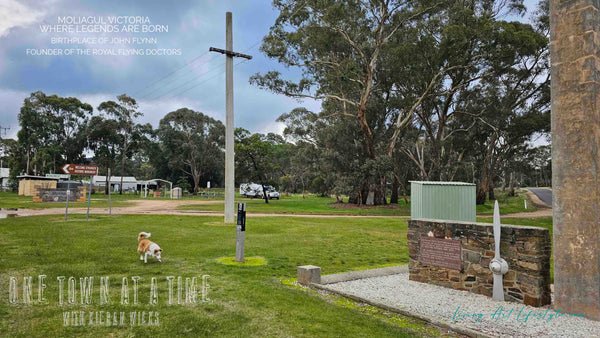
INCIDENTS OF VOYAGE.
One of the most striking features of the voyage was the fear which the aeroplane inspired in the natives of the more out-of-the way countries passed over. In Timor, for instance, the natives were seen hiding behind trees or throwing themselves flat on the ground in fear of the monster. The same was the case in Siam, Burma, parts of Syria. Nowhere did the natives show any hostility to the airmen, not even in the places formerly part of the Turkish Empire. From Crete the airmen flew to Heliopolis and then to Damascus, on to Ramadi, fifty miles north of Baghdad. Bassorah was the first stop. The longest time during which the ma chine flew continuously was nine and a half hours. This was from Karachi to Delhi. Here the airmen were obliged to take a roundabout route to avoid the great desert of north-western India. They had been warned that the very fine dust rising from the desert otherwise might injure their engines.
The Gods Must Be Crazy is a 1980 comedy film written, produced, edited and directed by Jamie Uys. An international co-production of South Africa and Botswana, it is the first film in The Gods Must Be Crazy series. Set in Southern Africa, the film stars Namibian San farmer Nǃxau ǂToma as Xi, a hunter-gatherer of the Kalahari Desert whose tribe discovers a glass Coca-Cola bottle dropped from an aeroplane, and believe it to be a gift from their gods. When Xi sets out to return the bottle to the gods, his journey becomes intertwined with that of a biologist (Marius Weyers), a newly hired village school teacher (Sandra Prinsloo), and a band of guerrilla terrorists. Despite its success, the film attracted criticism for its depiction of race and perceived ignorance of discrimination and apartheid in South Africa.
https://en.wikipedia.org/wiki/The_Gods_Must_Be_Crazy
DIFFICULTIES OF FLIGHT.
One of the airmen, who was emphatic about the fact that he would not like to make the flight again, explained that much trouble was caused by the various extreme changes in climate. Intense heat and wind slacked and cracked the woodwork and caused stresses and strains and very heavy labor in adjustments. Stays and parts expanded or contracted and had to be altered. "The mechanics worked till well into the night and four o'clock was their usual time for rising," he said.
"You had to get up then, for the natives who had told to call you never ceased knocking till you did. At Timor this morning, for instance, I thought we had struck an earthquake, but it was only a big Malay banging on the door." Much of the success of the voyage was probably due to the fact that Ross Smith and his companions had already surveyed the most difficult part of the route, that through the islands between Australia and India.
COMMERCIAL POSSIBILITIES.
One of the aviators expressed the view that with the route properly mapped out and with regular landing grounds and supply stations there is a strong prospect of the route being developed for commercial purposes in the near future. The line would, of course, be worked by relays of machines each doing a certain stage. He understood that the Vickers people had the matter in mind.
HOW THE WORLD LOOKS FROM AN AEROPLANE.
"Australia looks the best country we have seen on the flight, to us, anyway," said one of the arrivals. "Anyone can have the gorgeous East as seen from an aeroplane. What we saw of Java was mostly swamps and rice fields, and Timor is a wild-looking country. India did not impress us much from a bird's eye view and as to Syria and Mesopotamia, the less said the better. The boys told us that oranges were ripe in Palestine, but I did not see them. We were mighty glad to see first the "Sydney" and then the Australian coast rising away ahead. Captain Ross Smith expects to reach Melbourne in about four days after leaving Darwin. It is not likely that he will touch at Sydney on the way south.
MASCOTS FROM SIR JOHN ALCOCK'S MACHINE.
The radiator of the starboard engine of Captain Ross Smith's machine, formed part of the machine in which Captain (now Sir John) Alcock, made the first flight across the Atlantic. The Verey pistol on the G.E.A.U. (the letters stand for the registration number of Captain Ross Smith's machine) was also carried on the Atlantic flight.
AERIAL MAIL FROM SINGAPORE.
Captain Ross Smith brought to Darwin the first aerial mail received in Australia from overseas. This included a packet for Mr. Norman Bell, of the Mines Department, from his brother in Singapore. One article enclosed was a cutting from a Singapore newspaper of December 5, giving an account of the landing of the aviators at Singapore.
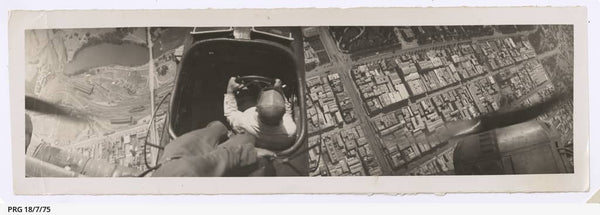
https://www.catalog.slsa.sa.gov.au:443/record=b3197962~S1
Aerial view of Adelaide taken from on board the Vickers Vimy, showing Ross Smith flying the aircraft into Adelaide, 23/3/1920.
THE NEWS IN ADELAIDE.
Adelaide, Friday — The news of the safe arrival of Captain Ross Smith and his party, three of whom are natives of South Australia, was received with much gratification and many expressions of delight in Adelaide.

https://www.catalog.slsa.sa.gov.au:443/record=b3197959~S1
Presentation of a cheque for 10,000 pounds to Ross Smith, by Prime Minister W.M. Hughes, at a luncheon given by the Commonwealth Government at the Queen's Hall of Parliament House, Melbourne, 27/2/1920. Walter Shiers, former Prime Minister Sir Joseph Cook, James Bennett, and Keith Smith are standing in the background.
THE £10,000 PRIZE.
Lieutenant Fysh, the Defence Department's representative at Darwin, and Major Macpherson, examined Captain Ross Smith's machine on Thursday and certified that the seals were intact, and the machine duly eligible for the £10, 000 prize offered by the Commonwealth Government to the first machine manned by Australians to fly from London, to Australia.


@kieran.wicks #OneTownataTime #InfiniteSkyChannel #AerialFootage #WorldFirst #Darwin #NorthernTerritory #Tourguide #Didyouknow #TouringMusician #TourDiary #RoomwithaView ♬ original sound - Kieran.Wicks
Goldeneye - Unisex Heavy Cotton Tee

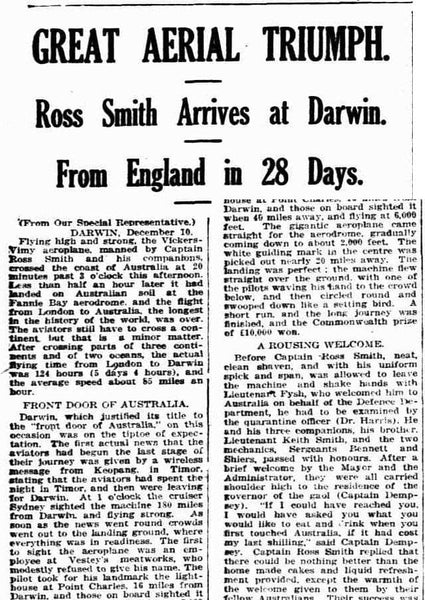
1919 'GREAT AERIAL TRIUMPH.', The Week (Brisbane, Qld. : 1876 - 1934), 19 December, p. 12. , viewed 29 Nov 2023, http://nla.gov.au/nla.news-article192745960
ARTICLE TRANSCRIPT
Ross Smith Arrives at Darwin.
From England in 28 Days.
(From Our Special Representative.)
DARWIN, December 10.
Flying high and strong, the Vickers Vimy aeroplane, manned by Captain Ross Smith and his companions, crossed the coast of Australia at 20 minutes past 3 o'clock this afternoon. Less than half an hour later it had landed on Australian soil at the Fannie Bay aerodrome, and the flight from London to Australia, the longest in the history of the world, was over. The aviators still have to cross a continent but that is a minor matter. After crossing parts of three continents and of two oceans, the actual flying time from London to Darwin was 124 hours (5 days 4 hours), and the average speed about 85 miles an hour.
FRONT DOOR OF AUSTRALIA. Darwin, which justified its title to the "front door of Australia," on this occasion was on the tiptoe of expectation. The first actual news that the aviators had begun the last stage of their journey was given by a wireless message from Keopang, in Timor, stating that the aviators had spent the night in Timor, and then were leaving for Darwin. At 1 o'clock the cruiser Sydney sighted the machine 180 miles from Darwin, and flying strong. As soon as the news went round crowds went out to the landing ground, where everything was in readiness. The first to sight the aeroplane was an employee at Vestey's meatworks, who modestly refused to give his name. The pilot took for his landmark the light house at Point Charles. 16 miles from Darwin, and those on board sighted it when 40 miles away, and flying at 6,000 feet. The gigantic aeroplane came straight for the aerodrome, gradually coming down to about 2,000 feet. The white guiding mark in the centre was picked out nearly 20 miles away. The landing was perfect: the machine flew straight over the ground, with one of the pilots waving his hand to the crowd below, and then circled round and swooped down like a setting bird. A short run, and the long journey was finished, and the Commonwealth prize of £10,000 won.
A ROUSING WELCOME.
Before Captain Ross Smith, neat, clean shaven, and with his uniform spick and span, was allowed to leave the machine and shake hands with Lieutenarft Fysh, who welcomed him to Australia on behalf of the Defence Department, be had to be examined by the quarantine officer (Dr. Harris). He and his three companions, his brother, Lieutenant Keith Smith, and the two mechanics, Sergeants Bennett and Shiers, passed with honours. After a brief welcome by the Mayor and the Administrator, they were all carried shoulder high to the residence of the governor of the gaol (Captain Dempsey). "If I could have readied you, I would have asked you what you would like to eat and drink when you first touched Australia, if it had cost my last shilling," said Captain Dempsey. Captain Ross Smith replied that there could be nothing better than the home made cakes and liquid refreshment provided, except the warmth of the welcome given to them by their fellow Australians. Their success was mainly due to the mechanics, Sergeants Bennetts and Shiers, who had worked tremendously hard.
SEARCH FOR DUTIABLE
ARTICLES.
The quarantine examination was not the only official barrier that the aviators had to pass. Mr. Geraghty (customs officer at Darwin) sought to see that all was in order. Captain Ross Smith replied that the machine had been examined by the customs officer in London, and passed, and that there had been no request for examination made by the customs at any of their stopping places. "It is a wash-out," he said. "We have nothing on board but spare parts, a little oil and petrol, pyjamas and a few clothes, and a tin of bully beef, stowed away somewhere," added Lieutenant Keith Smith. "I will give you my assurance that there is nothing dutiable on board," said Captain Ross Smith. Eventually the aviators received a list or dutiable articles, and it was decided that next day they should look through it and see that everything was in order.
VOYAGE TO AUSTRALIA.
The machine, which is a 360 horse power Vickers-Vimy, of the type used in the flight across the Pacific, left London on 12th November. It flew by way of Italy, Egypt, India, and Burma, to Bangkok, in Siam. to Singa-pore. From Singapore the route went through Java to Etching, at Soura-baya, to Anatopo, in Timor. The last stopping place is 500 miles from Dar-win, and the aeroplane left shortly after 8.30 this morning, covering the flight in about seven hours. A good deal of bad weather was encountered on the way. Early in the flight the machine had to land at Pisa, in Italy, on a ground covered by about 18 inches of water. Storms were met with later, but were usually avoided by rising above them. At Akyab ( in Burma, the Vickers-Vimy overtook M. Poulet, who was flying what one of the aviators de-scribed as rotten old bus." They left about the same time as M. Poulet next morning, but beat him by an hour M. Poulet took this like a good sport, and the next day both machines got under way for Bangkok. A storm which was encountered seemed to be too much for M. Poulet, and they saw him no more. The Vickers-Vimy had its worst time at Sourabaya, in Java. It landed on some reclaimed ground, and was nearly bogged, going right down on one side till one wing was nearly in the mud. Next morning it threatened to stick fast, but about 200 coolies set to work, and covered an area 300 yards long with bamboo matting. This enabled the machine to get a run and rise. The aeroplane was flying very light during the last part of the voyage. At Singapore the aviators jettisoned a photographic outfit, and everything else that could be spared. "Not on your life," said Lieutenant Ross Smith, when asked whether he had a wireless outfit, "it would weigh 150 lbs., and would not be worth it. Unless we had the means of giving an absolutely accurate position what would be the use of sending SOS calls, and wasting people's time looking for us." One of the aviators expressed the opinion that the disaster which overtook Lieutenants Ross and Douglas was due to having the machine overloaded.
NATIVES TERRIFIED.
One of the most trying features of the voyage was the fear which the aeroplane inspired in the natives of the more out of the way countries passed over. In Timor, for instance, the natives were seen hiding behind trees, or throwing themselves fiat on the ground in fear of the monster. The same was the case in Siam, Burma, and parts of Syria. Nowhere did the natives show any hostility to the air-men, not even in the places formerly part of the Turkish Empire. From Crete the airmen flew to Heliopolis, and then to Damascus, on to Ramaoi, 50 miles north of Baghdad. Bassorah was the next stop. The longest time in which the machine flew continuously was 9½ hours, and this was from Karachi to Delhi and there the airmen were obliged to take a round-about route to avoid the great desert of north-western India. They had been warned that the very fine dust rising from the desert might injure their engines.
WILL NOT REPEAT THE FLIGHT.
One of the airmen, who was emphatic about the fact that he would not like to make the flight again, explained that much trouble was caused by having only one machine, and so going the same throughout. Passing through so many different climates, with such great variation of heat and cold, caused stresses and strains, and very heavy labour in the adjustment of stays, and parts which expanded or contracted had to be altered. "The mechanics worked till well into the night, and 4 o'clock was their usual time for rising," he said. "You had to get up then, for the natives who had been told to call you never ceased knocking till you did. At Timor this morning, for instance, I thought we had struck. ah earthquake, but it was only a big Malay banging at the door." Much of the success of the voyage probably was due to the fact that Captain Ross Smith and his companions already had surveyed the most difficult part of the route, that through the islands between Australia and India.
VIEW FROM THE AIR.
"Australia looks the best country we have seen on the flight, to us, anywav said one of the aviators Anyone can have the gorgeous east as seen from an aeroplane. What we saw of Java was mostly swamps and rice fields, and Timor is a wild-looking country. It did not impress us much from a bird's eye view. As to Syria and Mesopotamia, the less said the better. The boys told us the oranges were ripe in Palestine, but we did not see them. We were mighty glad to see first the cruiser Sydney, and then, the Australian coast, rising away ahead."
KINDNESS OF THE DUTCH.
The aviators paid a tribute to the remarkable kindness and hospitality shown to by the Dutch residents of the places stopped at in the Dutch East Indies. "No one treated us like the Hollanders," said one of the mechanics. "They will do me. Nothing that they could do for us was left undone. They fed us well and rejoiced after us."
With the exception of a few reserves, such as the tin of bully beef, the aviators carried no food with them. They depended on securing it at the stopping places. Their last meal before reaching Australia was a few sandwiches given to them before they left, The weather in the Netherlands Indies was very bad—very hot and close, except when they were actually flying and well above the earth ; and with occasional heavy storms.
"NO JOY RIDE."
One of the mechanics summed up his views of the journey as a whole by saying that he would not do it again for £100,000. "Believe me, he said, "it was no joy ride. The engines went well, but, of course, we had to work practically every night at one thing or another. However, it is all right now."
One of the last things the aviators heard in London made them feel a little uncertain about what they would find at Darwin. The newsboys were calling out "Revolution in Australia," and selling by thousands newspapers giving a highly coloured account of the trouble in the Territory.
CAPTAIN WRIGLEY A DAY LATE.
The first aviators to reach Australia from overseas, and the first airman to fly across Australia, were within an ace of reaching Darwin on the same day. Captain Wrigley, who is flying a B.E. machine, left Newcastle Waters for Darwin this morning. He landed on the new ground at the Katherine about 2 o'clock, but met with a slight mishap in landing. It prevented him from flying the remaining 200 miles today.
AVIATORS ENTERTAINED.
The overseas aviators were entertained at dinner at the Victoria Hotel to-night by the residents of Darwin and visitors. The royal commissioner (Mr. Justice Ewing) presided, and proposed the toast or the aviators. Referring to their visit to Java, he said that he was surprised, after what he had been told of Java and its pleasures, that they got out of it under month.
Captain Ross Smith, in responding, said ; "It is very gratifying to know that we are the first to do this journey, principally because we are Australians. As to our feelings, we have just been going on from day to day. Two months ago we were working out our plans in London. We then had no arrangements as regards petrol and other things, especially in the stretch between India and Australia, but we had a machine from the Vickers' works, and with the Vickers' influence behind us, we got supplies out much more quickly than might otherwise have been the case. The greatest assistance has been given to us everywhere, and nowhere have we had such a welcome as at Darwin. (Cheers.) On behalf of myself and my companions, I thank you most heartily." (Cheers.)
HOW THEY GOT OUT OF JAVA.
Lieutenant Keith Smith, asked to explain how they got out of Java said : "We got out of Java on bamboo matting. We reached Sourabaya at noon, spent seven hours digging out the aeroplane, and three hours eating our dinner, and then got up at 6 o'clock in the morning, and spent five more hours in digging out the aero-plane. That is how we left Java,"
DARWIN, PAST AND FUTURE.
The Administrator proposed the toast of Darwin and its citizens. He said that practically 50 years ago the cable was brought to Darwin which first brought Australia into touch by cable with the outside world. That day it had been the landing place of the Australian aviators, whose skill and daring had forged a new link between Australia and the outer world.
The Mayor, in responding, said that their guests had made Darwin the front door, not the back door, of Australia, and he looked forward to seeing Darwin the last port of call, and entry for a speedy mail and passenger service by air between the cities' of the south, and Europe, Asia, and America. Within a few years they hoped to see a railway across Australia, and Darwin a great port. The gentlemen who had arrived from the clouds had initiated a great development of the Territory. He expected to see aeroplanes used for communication with the outlying stations. Some years ago Vestey's had proposed to secure an aeroplane for this purpose, but they were prevented by the war. At the close of the banquet a lady kissed all the aviators.
WELCOME AT DARWIN.
Hundreds of cable, wireless, and telegraphic messages of congratulation on accomplishing the great feat, awaited Captain Ross Smith on his arrival, including one from the Prime Minister (Mr. Hughes). Others came from all parts of Australia.
The administrator received the following message : —
"We request that you will give the following message to Captain Smith from the captain and officers of the cruiser Sydney : Many thanks for your kind message received, latitude 10 degrees, 57 minutes south. We offer our heartiest congratulations to you and your companions on winning the greatest race in the history of the world, and on the skill, gallantry, and endurance all have shown. We are particularly proud to feel that the first to fly from England to Australia is an Australian."
The administrator also received the following telegram from West Australia : "Kindly deliver this message, which we particularly wish you to give to the first aviator, arriving at Dar-win. as follows: The north-western members of the West Australian Parliament welcome you on your safe arrival on Australian soil. Your wonderful performance thrills us with admiration. We congratulate you as the first great air pilots of Australia, fulfilling the prophecy of Tennyson, when he dipped into the future and saw the vision of the wonders that would be. By your achievement the world is brought closer to us, realising visions for community of joy and delight.
(Signed by Sir Edward Wittenoon, Messrs. J. J. Holmes, S. W. Miles, P. Durack, R. W. Underwood. F. O. Tees dale, E. H. Angelo.)
The landing was very spectacular, and very picturesque, in fine weather.
The Mayor presented an address on behalf of the citizens, signed by himself and the administrator.
The following is a copy of the address of welcome read by the Mayor (Ald. Toupein) to Captain Ross Smith : "The citizens of the Northern Territory of Australia are privileged to be the first to welcome you valiant knights of the air, who have crossed the wide continents and oceans of the world, whose dauntless courage has conquered the last of the elements, and made it the handmaid of progress and civilisation. We are especially gratified to feel that the victory has been won by Australians, who have been trained in many an aerial conflict in the late war. This great contest over space, in which you have been so signally successful, has placed the coping stone on the triumphal arch raised by Australian valour on the great battlefield of the world. It has enshrined Australian chivalry and resource in the pantheon of the nations, where the whole world will do homage to your unique exploit. (Signed) on behalf of the residents of the Northern Territory, Staniforth Smith, Acting Administrator; Robert Toupein, Mayor of Darwin, Northern Territory of Australia, 10th December, 1919."
Captain Ross Smith replied to the welcome. He said that he had hoped to make the journey in 30 days, but was proud to say he had done it in 28. He was proud as an Australian to be back in Australia and to receive such a rousing welcome from real Australians.
At the citizens' banquets to-night, despite influenza regulations to the contrary, the crowd rushed the aviators and carried them shoulder high from the ground. Men and women were struggling to get in and shake hands with the aviators.
STAY AT DARWIN.
DARWIN, December 11.
Firmly anchored down, and under a police guard, Captain Ross Smith's aeroplane was left at the Fanny Bay aerodrome last night. Today the mechanics set to work repairing it in readiness for the last stage of the flight, which is to be begun on Saturday. Captain Ross Smith found, on examination, that the ground was just about large enough to allow the machine to rise when fully loaded with petrol. The next point-at which petrol is available is Avon Downs, 690 miles from Darwin.
There is not a very large supply there, but Cloncurry is about 200 miles further on, with ample supplies. Captain Ross Smith has decided that it would be impossible to attempt to reach Cloncurry in one flight. Beyond Clon-curry depots have been established at Charleville and at Narromine, near Dubbo. Captain Ross Smith has been requested to visit Sydney on his way south, and it is possible that he will do so. Maps of the country to be passed over between Darwin and Cloncurry were handed to the aviators by Lieutenant Fysh this afternoon. Captain Ross Smith has satisfied the requirements of the customs and the health authorities.
THE AEROPLANE.
The aeroplane is similar in type to that used by Captain Alcock for the flight across the Atlantic, and in fact some of the parts were used for that flight. The engines were sent to America as spares, but were not used for the Atlantic flight, and they are 350 h.p., developing up to 375 h.p. The wings have a span from tip to tip of 67 feet. Three of the aviators are from South Australia, though Sergeant Shiers has lived for years in New South Wales. The other mechanic, Sergeant James Bennett, is from St. Kilda.
TRIBUTE TO THE PILOT.
Both the mechanics were with the Handley-Page machine which made the first flight from Cairo to Calcutta, and afterwards spent three months on the Afghan frontier. With characteristic modesty, Captain Ross Smith yesterday attributed the success of his work to the mechanics. "lt was all right of him to say it," said one of the mechanics this morning, "but it is the pilot who does it, and Captain Ross Smith will do me as a pilot every time. When he says he will do a thing he will do it. Nothing flusters him, and perhaps in him Australia has the greatest pilot in the world. When we were stuck at Sourabaya, and it did not lock as if we would ever get out, he had just the same smile on his face as he has now. All through the trip he was just the same—always cool, ready, and pleasant. It is a great thing to be able to say that we have flown with Ross Smith. The way he steered round or through those storms was a marvel."
EXPERIENCES ON THE ROUTE.
Interesting sidelights on flying round the world were given by the aviators in conversation. One trouble was that of money. They would fly 500 or 600 miles, and land late in the day in a country with an entirely new currency and, naturally, have no money to pay with. Their experiences of climate were most varied. The start was made in a snowstorm, and the landing in Darwin with the shade temperature about 90 degrees. Whilst most of the flight was made at not more than 4,000 feet, the machine rose to 8,000 feet to try to get above the snowstorm, and the temperature fell to 25 degrees below zero, and the machine looked like a miniature iceberg. The sandwiches froze so hard that they could not be bitten until thawed a little in the mouth and the coffee almost froze in the thermos flasks. "There were storms enough, of wind and rain but nothing so bad as this. "I am satisfied, now that the School of Geography were right when they said that the world is two parts water and one part land, said one of the aviators to-day. "We seemed to be over water most of the way, but I guess that we were better without floats. If you are going to fly in a seaplane, do it, but it is no use trying to have the machine half and half.
GREAT INTEREST IN BRITAIN.
LONDON, December 10.
The arrival of Captain Ross-Smith in Australia created the keenest interest, and the newspapers paid warm tributes to the wonderful feat of endurance and skill. Ministers are sharing with the public the interest which is being taken in the final stages of the flight, and are sending congratulatory messages through official channels.
The Director of Civil Aviation (Air Vice-Marshal Sykes), in an Interview with a representative of the Australian Press Association, said the flight was from every point of view a brilliant and wonderful undertaking, and it would live in the history of aviation. It was intensely satisfactory to know that the journey had been accomplished by an Australian crew on a British machine, and with British engines, assisted by British organisation. Although the aviator had faced continuous bad weather, nothing had seriously impeded their remarkable progress, and Australia had reason to be proud of Captain Ross-Smith and his gallant crew.
ln order to view the feat in its true perspective, it was necessary to regard it as a great pioneer undertaking. lt was part of the spade work of which much remains to be done before their dreams developed and imperial air routes could be realised. No one more than Captain Ross Smith appreciates the large measure of his success, due to the ground work undertaken before and during the flight, such as arranging landing grounds, meteorological reports, and facilities for crossing foreign countries. It was by the improvement of these arrangements that we could look forward to the development of the Imperial air routes. No doubt each dominion would forge its own link in the invisible imperial chain to suit its own requirements. Doubtless, flying boats would be suitable in some places, and aeroplanes in others. Captain Ross Smith's achievement was greatly helpful. It Showed where the gaps in meteorological and other information occurred, and taught something of air currents, of which we were at present ignorant. Although the flight offered a wonderful endurance test, the future of long-distance flights lay in the relay system. They must not yet expect the establishment of a weekly service with Australia, but the Commonwealth Government de-served credit for initiating and promoting the contest and in bringing together the two ends of the Empire, and the Dutch Government had shown the great value of international co-operation in the East Indies. Admiration for Captain Ross Smith did not deter one from expressing appreciation of M. Poulet's wonderfully plucky effort Mr. Holt Thomas, the contractor for the London-Paris mail service, told the Australian Press Association that he regarded Captain Ross Smith's achievement as one of the finest aviation exploits on record, and that it reflected the greatest credit on the pilot and crew of the aeroplane and the designers of the engines. It was a magnificent performance, which demonstrated that by flying relays aerial services would soon become practical throughout the world.
LONDON, December 10.
In reply to a question in the House of Commons, the Secretary of State for War (Mr. Winston Churchill) confirmed the report that Captain Ross Smith had arrived in Australia, and offered the congratulations of the House amid cheers.
In the House of Lords, Lord Montagu of Beaulieu said that the achievement was an epoch In the history of the air force.
KING'S CONGRATULATIONS.
MELBOURNE, December 12. The King has sent, through his Excellency the Governor-General (Sir Ronald Munro-Ferguson), the following message to Captain Ross Smith: "Delighted at your safe arrival. Your success will bring Australia nearer to the mother country, and I warmly congratulate you and your crew. (Signed) GEORGE R.I."
OTHER MESSAGES.
The following messages have also been received by his Excellency the Governor-General for transmission to Captain Ross Smith:---
1 "Heartiest congratulations. Your flight shows how the inventions of the war can advance the progress of peace." (Signed) D. LLOYD GEORGE, Prime Minister of Britain.
- "Well done. Your great flight shows conclusively that the new element has been conquered for the use of man." (Signed) W. S. CHUR-CHILL, Secretary of State for War and Air.
- "Many congratulations on successful forging of new link." (Signed) L. S. AMERY, Under Secretary for the Colonies.
- "Air Council congratulates you and crew on the great skill and endurance shown in your achievement." (Signed) W. A. ROBINSON, Government Secretary to the Air Council.
- "Most sincere congratulations on successful termination of your great flight. Your progress has been watched by all here with the keenest interest" (Signed) F. H. SYKES, Chief of Air Staff.
The Australian Natives' Association has sent a telegram to Captain Ross Smith, congratulating him and his crew on their magnificent success. The association rejoices to know that an Australian native has won so great an honour. The following is the wording of the message sent to the aviator:—
"The Australian Natives' Association extends congratulations to you as a fellow Australian on success achieved, and recognise value of your crew's assistance." (Sgd.) C. A. Powell, general secretary.
NEW YORK, December 10.
The "New York Times," in an editorial, says: "Captain Ross Smith has done a wonderful thing for the prestige of the British Empire. He must be hailed as the foremost living aviator, for he never blundered or faltered."
TRIBUTES IN BRITAIN.
LONDON, December 11.
At a conference at the Royal Aero Club the High Commissioner for Australia (Mr. A. Fisher) decided that, subject to the verification of the machine, Captain Ross Smith was the winner of the Commonwealth prize of £10,000 for a flight to Australia, having fulfilled all the conditions.
The club has cabled its congratulations to Captain Ross Smith on his "epoch-making flight."
The Director-General of Civil Aviation (Air Vice-Marshal Sykes) has sent messages to the Vickers and Rolls-Royce firms, congratulating them on providing the winning machines and engines, for the Australian and Atlantic flights.
The newspapers devote leading articles to Captain Ross Smith's success. They quote the King's message that the success will bring Australia nearer to the mother country.
The "Daily Telegraph" expressed the opinion that the flight will rank in air navigation, with the efforts of Columbus and Vasco da Gama in ocean navigation. Nevertheless, the age of wonders for aviation lies ahead, and not behind us."
Captain Sir John Alcock, who flew across the Atlantic, states that Captain Ross Smith's wonderful achievement is a triumph for British aviation, and also sets the hallmark of reliability, and endurance for the machine and engine.





























